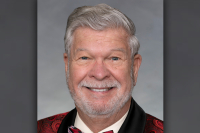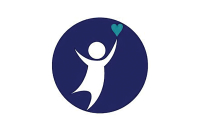Hymnbook breathes life into Cherokee lyrics
 It’s Sunday afternoon, and a quartet of musicians — one guitarist, three vocalists — stands at the front of a small room whose rows of chairs hold about twenty people. The guitarist strums a few chords, and the voices join in a familiar tune, “Amazing Grace.”
It’s Sunday afternoon, and a quartet of musicians — one guitarist, three vocalists — stands at the front of a small room whose rows of chairs hold about twenty people. The guitarist strums a few chords, and the voices join in a familiar tune, “Amazing Grace.”
A typical Sunday scene in Western North Carolina, perhaps, except that the syllables filling the room at the Museum of the Cherokee Indian form neither the words “amazing” nor “grace.” In fact, there’s not a word of English in them. Though the tunes were written for English hymns, the words are Cherokee, lyrics to songs with a long history among the Cherokee people.
“My mom and dad used to sing a lot of Cherokee songs to us back when I was little, so I memorized them then,” said Shirley Oswalt, a tribal member from Robbinsville who was one of the four musicians from Snowbird Baptist Church.
Cherokee is Oswalt’s first language, and that’s not a common thing, these days. Only 219 fluent speakers remain.
“It’s changed a lot,” Oswalt said, reflecting on the decline of the language. “Everybody speaks English now, which it’s hard to reverse that, which is what we need to do.”
Related Items
Not because there’s anything wrong with speaking in English – that’s how Oswalt and her husband Mack, who is not Cherokee, communicate – but there is something wrong with losing a language.
As a billboard placed at the entrance to the reservation puts it, “Without your language, what makes you Cherokee?” Below the question is a trio of flipboard numbers denoting how many fluent speakers remain. Right now, the number is 219.
“It’s like any other language,” Oswalt said. “Once you translate, things get lost.”
Writing the hymbook
The hymnbook that Oswalt and her three fellow musicians sang from is part of the effort to stave the sacrifices to translation. It includes the same 143 Cherokee songs that were printed in a little paper songbook published in 1829, a book that nearly every Cherokee family owned.
But the new book puts the songs to music, and it translates the meanings of the words into English. The Cherokee people didn’t have a system to write down musical tunes, so as the language was used less and less, the songs began to disappear.
That’s what Dan Dills, a Knoxville man whose Cherokee family left the reservation two generations ago, discovered as his heritage started to become more important to him. He and his dad attended a class on Cherokee language at the Sequoyah Birthplace Museum in Vonore, Tenn., which is owned by the Eastern Band of Cherokee Indians. That’s when Dills saw his first sheets of Cherokee songs, and he and his dad soon became “really involved and active” in learning them.
“We started singing in public, and we didn’t have enough songs,” Dills said. Of the 143 songs listed in the 1829 hymnal, only a smattering of tunes remained.
The desire to bring those slumbering songs back to life launched Dills into a project that would consume more than 2,000 hours of his time before a finished, printed book graced the museum bookstore’s shelves.
The task? Take a nearly 200-year-old paperback written in Cherokee syllabary, translate the words into English phonetics so people who can’t read Cherokee can say them, and then find hymns with time signatures and rhythms that match the Cherokee.
“Every note is matched to a syllable so you can just pick that up and sing the song in Cherokee,” said Barbara Duncan, education director at the museum.
On top of the phonetic translation, the hymnbook also includes a translation to the English meaning, which runs alongside the musical notation. The English tunes were chosen for timing and rhythm, not meaning, so the translation is necessary so that non-Cherokee speakers know what they’re singing.
“The project sounds simple, but this was a long project that took a long time,” Duncan said.
SEE ALSO: Hymn 87, Music and Phonetics | Hymn 87, Syllabary and Translation
A restoration project
The goal is to create something that will engage people, especially youth, especially Cherokee, who don’t know the language – and that bringing those songs to life again will help ignite a restoration of the language.
“I believe when we sing it in the language, it takes on a new meaning,” said Matthew Tooni, 26 who came to sing Sunday. “It’s different singing it in your own language than it is in any other language.”
Tooni, a tribal member, speaks some Cherokee, though not fluently. But he’s in love with his culture and hungry to know more about it.
Sarah Burkey, 34, shares Tooni’s love of the culture.
“I learned a lot of the hymns already, but I wanted to sing them with more people,” she said.
Having grown up with the hymns, she said, “it’s just part of me, part of who I am,” and she’s invested a lot of time into learning them well.
The hymnsing, sponsored by the North Carolina Arts Council, was a chance for those words to gather meaning for more people. Duncan told the audience the story of the new hymnbook’s creation, and Oswalt tutored them on how to pronounce the Cherokee words. After the Snowbird Baptist group ran through their songs, Joyce Cooper, who put in 600 hours formatting the book, sat down at the piano and led some more.
“If people like it and they want [another sing-day], we will,” Duncan said.
Afternoon singing is just one small part of saving a language, though. It will take people like Burkey and Tooni, and younger children like the little girl who stepped up in the midst of the performance to sing a Cherokee version of “Jesus Loves Me,” to keep the Cherokee language alive, Oswalt said.
“I’m just hoping the young people can get a hold of it and use it,” she said of the hymnbook, “and I think it’s going to be the younger generation, because the older generation is used to singing them with the English words.”
That’s important enough to Oswalt that she spent a good part of the last two years working with three other women — Janie Brown, Mary Brown and Anna Sixkiller — to translate the Cherokee hymns into English words.
Though “in comparison to life it was a very short time,” Oswalt said, for those two years “it was like every waking moment.”
But time is of the essence, and much has already been lost.
“It would be great if we had a tune for all the songs, but we don’t,” Oswalt said, “and in any song, the words are the most important part.”
This way, the words will be preserved.
Buy a book
The Cherokee Hymnbook is on sale through the Museum of the Cherokee Indian, both at the museum and online at www.cherokeemuseum.org. The book, whose production was sponsored by the Cherokee Preservation Foundation, includes 143 songs featuring Cherokee syllabary, Cherokee phonetics, new English translations and musical notation. Spiral-bound books are $25 and hardcover books are $40.









